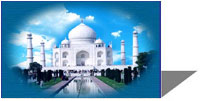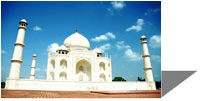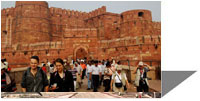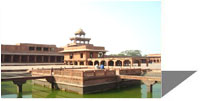Agra is situated on the bank of Yamuna river, situated between 27°11' Nor

th latitude and 78°0' degree to 78°2' East longitude, at 169 meters above sea level. On the north it is bounded by Mathura, on the south by Dhaulpur, on the east by Firozabad, and on the west by Bharatpur. Travel to the great historical city of Agra and understand why Taj Mahal is considered as the "Love of a Man Epitomized in Stone". Travel to Agra and discover the fact that Agra is not only Taj Mahal but much more. The architectural splendor of the city is reflected in the glorious monuments of medieval India built by great Mughals who ruled India for more than 300 years. Travel to Agra and experience the the organized chaos that is India. India is best understood from the rampages of Agra Fort and nothing else.
The monument was commissioned in 1631 and took 20,000 artisans, 22 years to complete. An entire township now known as Taj Ganj came up around the site. Here, craftsmen live and sell their wares of marble and stone inlay and replicas of the Taj. After the reign of the last great Mughal, Aurangzeb, Agra fell into the hands of the Jats and then the Marathas. In 1803, the British under General Lake captured the city. Once again, it secured its position of eminence as the capital of the north-western provinces.
Climate
In summer, between March and June, the temperature soars up to 45°C during the day. Dry, searing winds heat up the ground and make it difficult to venture outdoors. Light cottons are the best clothing, except in winter, when light woollens are required. The temperature is around 28°C during the day, but can go down to 4°C at night.
Taj Mahal 
Situated on the banks of the River Yamuna, the Taj Mahal stands at the northern end of formal gardens. The white marble came from Makrana in Rajasthan and the red sandstone from Fatehpur Sikri. Precious stones like jade, crystal, turquoise, lapis lazuli, sapphire, jade, coral and diamonds were brought from far-flung places in Tibet, China, Sri Lanka, Persia and Afghanistan. It is believed that a fleet of 1000 elephants was used to transport the material.
Agra Fort
Agra's dominant structure and the World Heritage Site, the Ag

ra Fort, also called the Red Fort, was rebuilt by Akbar in 1565. The red sandstone fort was renovated and converted into a palace during Shah Jahan's time, and reworked extensively with marble and pietra dura inlay. Notable buildings in the fort include the Pearl Mosque, the Diwan-e-Am and Diwan-e-Khas (halls of public and private audience), Jehangir's Palace, Khaas Mahal, Sheesh Mahal (mirrored palace), and Musamman Burj.
Itmad-Ud-Daulah's Tomb
Empress Nur Jehan built Itmad-Ud-Daulah's Tomb, sometimes called the Baby Taj, for her father, Ghias-ud-Din Beg, the Chief Minister of Emperor Jahangir. Small in comparison to many other Mughal-era tombs, it is sometimes described as a jewel box. Its garden layout and use of white marble, pietra dura, inlay designs and latticework presage many elements of the Taj Mahal.
Fatehpur Sikri
The founding of Fatehpur Sikri reads like a fairytale. When all else had faile

d, the EmperorAkbar came here in search of the renowned Sufi mystic, Sheikh Salim Chishti, to ask the blessing of a son. His prayer was heard, and soon a son was born. In honour of the saint, Akbar named the prince Salim and vowed to found a new city. And so Fatehpur Sikri, a magnificent new city rose on the craggy hills 40 kms from Agra. And for 16 short butmemorable years it was the wonder of travellers from all over the world.
Today, Fatehpur Sikri is a deserted, phantom city. But the inner citadel is immaculately preserved. Its walls, palaces, baths, royal mint,courts and gardens still stand in splendidhomage to a great visionary and builder. The heart of the palace complex however, is verymuch alive. For at the tomb of Sheikh Salim Chishti, a white marble canopy set in the greatcourtyard of the Royal Mosque, pilgrims still come in thousands to offer flowers, tie a threadin the latticed screens, and to pray for the gift of son.
How to reach